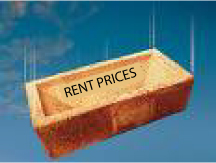Posted by Teresa on September 13, 2011 under Housing Trends, Rental Market | 
 According to the U.S. Census Bureau, there has been a big jump from 2007 in the number of individuals and families doubling up in housing. The definition of “doubled-up” households are those that include at least one person over age 18 who is not in school, not the householder, and not a spouse or partner of the householder.
According to the U.S. Census Bureau, there has been a big jump from 2007 in the number of individuals and families doubling up in housing. The definition of “doubled-up” households are those that include at least one person over age 18 who is not in school, not the householder, and not a spouse or partner of the householder.
The Census Bureau says 69.2 million, or 30%, of adults were doubled-up in 2010, compared to 61.7 million adults, or 27.7% in 2007. Total American households who have doubled up due to unemployment or underemployment stands at 18.3%.
Much of the increase comes from people aged 25 – 34, living with their parents. That number increased from 4.7 million before the recession to 5.9 million (14.2% of the age group) in 2010.
The study was done as part of the Census Bureau’s wider report on income, poverty and health insurance. The report shows that household incomes dropped sharply last year. Since 2007, they have fallen 6.4%. Not surprisingly, the number of people living in poverty rose sharply, up for the fourth year in a row to 46.2 million people, or 15.1%.
If counted separately, some 45% of the young adults who live with their parents would fall below the poverty threshold. Because an entire household’s income is counted when determining poverty status, the group has an official poverty rate of only 8.4%.
What does the Census Bureau data mean for landlords?
- Fewer households mean lower demand for rental housing.
- Americans have less income to spend on housing and other necessities.
- Fewer home sales will continue to drag the housing market down.
- Once the economy starts to improve, many of the families and adult children will move out on their own, spurring a strong demand for housing.
Now, if only the economy would start to improve!
Posted by Teresa on August 17, 2011 under Housing Trends, Rental Market | 
 Real estate investors have long been active in college towns for a number of reasons. Rentals are often short-term and dealing with younger students as tenants can be problematic, but when mom and dad co-sign the lease, they tend to pay the rent on time every month.
Real estate investors have long been active in college towns for a number of reasons. Rentals are often short-term and dealing with younger students as tenants can be problematic, but when mom and dad co-sign the lease, they tend to pay the rent on time every month.
College enrollments are up, and on-campus housing is in short supply. Demand for rentals is high and vacancies low, so rents are generally healthy. All told, college students who need a place to live can be excellent prospective tenants—and rental property in a college town can be a great opportunity, if the terms and price are right for you.
Move.com recently published a list of the best university cities for real estate investment. Here’s how their ratings shook out:
| City |
Median List Price |
Average Rent, 2BR |
Average Rent, 3+BR |
| Boston |
$335,000 |
$3,122 |
$3,913 |
| Nashville |
$189,000 |
$949 |
$1,020 |
| Chicago |
$199,900 |
$1,780 |
$2,074 |
| Washington DC |
$375,000 |
$3,086 |
$3,214 |
| Houston |
$174,900 |
$1,218 |
$1,478 |
| South Bend, IN |
$112,900 |
$790 |
$880 |
| Atlanta |
$159,600 |
$1,236 |
$1,485 |
| Baltimore |
$242,700 |
$1,443 |
$1,663 |
| St. Louis, MO |
$163,945 |
$1,016 |
$1,283 |
| Syracuse, NY |
$154,900 |
$838 |
$970 |
- Boston has over 50 colleges and list prices have dropped nearly 3% since last June. Rents are on the rise.
- Nashville’s average rents are higher than the average mortgage of $770.
- Chicago’s median list price is down over 16% since last June.
- Washington DC’s average mortgage for a median-priced home is around $1,530.
- Houston has low-priced inventory and some top-ranked colleges. Average mortgage is about $710.
- South Bend is home to Notre Dame and the average mortgage payment is around $990.
- Atlanta’s median list price is down 13.68% from last June, and lower than the national median.
- Baltimore is home to Johns Hopkins University, with median prices down 7.72% since last year.
- St. Louis, MO ‘s median list price is also lower than the national average, and mortgage payments average around $670.
- Syracuse is home to Syracuse University, as well as several other colleges. Median prices are down and the average mortgage payment is around $630.
College towns have a ready-made pool of renters, and generally, the rent money is not a problem. Manage the property correctly, and you could have a successful investment for years to come.
Posted by Teresa on January 7, 2010 under Housing Trends, Rental Market | 
Reis, Inc., a real estate research firm just released its 4th Quarter 2009 apartment vacancy report. As expected, it hit 8%—the highest in thirty years. The poor state of the U.S. job market continues to be blamed, as job creation lags behind other positive economic indicators. Young people, who are typically apartment renters, have been hit especially hard in the job market.
A bit more positive is the news that an ever-increasing supply of newly built apartment units is starting to decline—finally catching up with the credit crunch that began in the summer of 2008. 28,000 new apartments came onto the market in the 4th quarter 2009. The total for the year: 120,000, including developments intended for condos that converted to rentals. New apartment supply should fall by half in 2011, and if jobs improve, there could be some rental market recovery by the middle of this year, according to the report.
The U.S. apartment vacancy rate rose .10 percent from the 3rd quarter, and 1.3 percent for the year, ending at 8%. Sunbelt cities like Tucson AZ, and Jacksonville, FL experienced huge vacancy increases in 2009, at 10.5% and 14.4%, respectively. Charlotte, NC and Lexington, KY were also hit hard. Nationwide, vacancies increased in 52 markets, improved in 17, and remained flat in 10.
Not only are vacancies higher than ever, but landlords are experiencing a double-whammy: both asking and effective rents are plummeting. For 2009, asking rents fell 2.3%, also the largest decrease in thirty years; effective rent fell .7% to $964 per square foot.
And while mortgage financing has toughened up, government efforts to enhance the housing market threaten apartment owners, as some renters find it easier to buy a home. In some markets, continued unrest in the housing sector and lower rents will make renting more attractive than buying.
Landlords and rental property owners will likely need to continue offering rent reductions, perks and amenities to entice new tenants—until the job market improves. And when that will happen is anybody’s guess.
 Reis, Inc., a real estate research firm just released its 4th Quarter 2009 apartment vacancy report. As expected, vacancies hit 8%—the highest in thirty years. The poor state of the U.S. job market continues to be blamed, as job creation lags behind other positive economic indicators. Young people, who are typically apartment renters, have been hit especially hard in the job market.
Reis, Inc., a real estate research firm just released its 4th Quarter 2009 apartment vacancy report. As expected, vacancies hit 8%—the highest in thirty years. The poor state of the U.S. job market continues to be blamed, as job creation lags behind other positive economic indicators. Young people, who are typically apartment renters, have been hit especially hard in the job market.
A bit more positive is the news that an ever-increasing supply of newly built apartment units is starting to decline—finally catching up with the credit crunch that began in the summer of 2008. 28,000 new apartments came onto the market in the 4th quarter 2009. The total for the year: 120,000, including developments intended for condos that converted to rentals. New apartment supply should fall by half in 2011, and if jobs improve, there could be some rental market recovery by the middle of this year, according to the report.
The U.S. apartment vacancy rate rose .20 percent from the 3rd quarter, and 1.3 percent for the year, ending at 8%. Sunbelt cities like Tucson AZ, and Jacksonville, FL experienced huge vacancy increases in 2009, at 10.5% and 14.4%, respectively. Charlotte, NC and Lexington, KY were also hit hard. Nationwide, vacancies increased in 52 markets, improved in 17, and remained flat in 10.
Not only are vacancies higher than ever, but landlords are experiencing a double-whammy: both asking and effective rents are plummeting. For 2009, asking rents fell 2.3%, also the largest decrease in thirty years; effective rent fell .7% to $964 per square foot.
And while mortgage financing has toughened up, government efforts to enhance the housing market threaten apartment owners, as some renters find it easier to buy a home. In some markets, continued unrest in the housing sector and lower rents will make renting more attractive than buying.
Landlords and rental property owners will likely need to continue offering rent reductions, perks and amenities to entice new tenants—until the job market improves. And when that will happen is anybody’s guess.
 According to the U.S. Census Bureau, there has been a big jump from 2007 in the number of individuals and families doubling up in housing. The definition of “doubled-up” households are those that include at least one person over age 18 who is not in school, not the householder, and not a spouse or partner of the householder.
According to the U.S. Census Bureau, there has been a big jump from 2007 in the number of individuals and families doubling up in housing. The definition of “doubled-up” households are those that include at least one person over age 18 who is not in school, not the householder, and not a spouse or partner of the householder.

